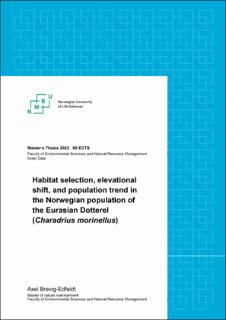| dc.description.abstract | Climate change occurs at a faster rate in alpine areas and in northern latitudes compared to
other regions. However, we have too little knowledge of the consequences of such changes
within alpine areas. Studies regarding this subject have to our knowledge been geographically
restricted, mainly to central Europe and the western hemisphere. We conducted a study in
Norway during the breeding season regarding the Eurasian Dotterel (Charadrius morinellus).
We counted territories, registered site variables, and used historical data to address the
population trend and to uncover a potential shift in elevation. We found a significant, negative
relationship between the number of territories and the density of sheep. Additionally, different
levels of bedrock nutrition influenced the number of territories, where areas with intermediate
bedrock richness contained the most territories. The mean elevation of a territory was 1429 m
a.s.l. (range: 1221-1656 m a.s.l.) We also found that the dotterel had experienced an
elevational shift in Norway from 1970 to 2022, equalling an upward shift of 17.4 m a.s.l. for
each decade. If this trend continues, the loss of breeding habitat in our study sites may amount
to ca 20% during the next 50 years. However, we found no significant shift in elevation for the
period 2008-2022 in the same region. The population trend within our study sites was also
stable from 2008 to 2022. Even though we found a stable population trend, a continued shift in
the elevation will likely lead to future population declines. A potential management tool that
we present here, is to limit the density of grazing sheep in alpine breeding areas. It might also
be crucial for management to gather more data regarding population trends in alpine birds and
the potential drivers for elevational shifts. Such data could then be used to create mitigating
efforts to reduce the effects of these drivers. | |
